| Solar eclipse of October 26, 2144 | |
|---|---|
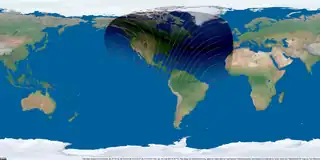 Map | |
| Type of eclipse | |
| Nature | Total |
| Gamma | 0.8037 |
| Magnitude | 1.0512 |
| Maximum eclipse | |
| Duration | 245 sec (4 m 5 s) |
| Coordinates | 39°12′N 71°12′W / 39.2°N 71.2°W |
| Max. width of band | 284 km (176 mi) |
| Times (UTC) | |
| Greatest eclipse | 17:32:40 |
| References | |
| Saros | 155 (13 of 71) |
| Catalog # (SE5000) | 9834 |
A total solar eclipse will occur at the Moon's ascending node of its orbit on Monday, October 26, 2144. A solar eclipse occurs when the Moon passes between Earth and the Sun, thereby totally or partly obscuring the image of the Sun for a viewer on Earth. A total solar eclipse occurs when the Moon's apparent diameter is larger than the Sun's, blocking all direct sunlight, turning day into darkness. Totality occurs in a narrow path across Earth's surface, with the partial solar eclipse visible over a surrounding region thousands of kilometres wide. This total solar eclipse is the first large one visible from New York City since January 24, 1925 (there is another one in 2079, but a few minutes after sunrise)[1] and the second visible from the Azores in only 2.4 years. Totality lasts 4 minutes and 5 seconds, occurring at 12:29:39 EST in the North Atlantic Ocean, just off the coast of New Jersey. Occurring just two hours before perigee (Perigee at 14:14 EST on the same day),[2] the Moon's apparent diameter will be larger.
This will be the 13th of 71 eclipses from Solar Saros 155. The next eclipse in the series – tied with this one for the longest total – will occur on Saturday, November 6, 2162.
Visibility
It will begin at sunrise over northwestern Canada, then move southeast through Canada (Northwest Territories, British Columbia, Alberta, Saskatchewan, Manitoba, Ontario) and the United States (Minnesota, Wisconsin, Michigan, Ohio, Pennsylvania, New York, Connecticut, Delaware, and New Jersey) before setting out to sea and ending at sunset after the Azores. This eclipse offers totality to parts of all five Great Lakes on the Canada–United States border.
Partiality will be visible across nearly the entire North American continent, in addition to western Africa, western Europe, and northern South America.
Locations experiencing totality[3]
Ontario
Pennsylvania
New York
Connecticut
New Jersey
- Jersey Shore region
Azores
Related eclipses
Saros 155
It is a part of Saros cycle 155, repeating every 18 years, 11 days (223 synodic months), contains 71 events. The series started with a partial solar eclipse on June 17, 1928. It has total eclipses from September 12, 2072 to August 30, 2649. The series also has 3 hybrid eclipses from September 10, 2667 to October 3, 2703 and 20 annular eclipses from October 13, 2721 to May 8, 3064.
The series ends at member 71 as a partial eclipse on July 24, 3190. The longest total eclipses will be on October 26, 2144 and on November 6, 2162, at 4 minutes and 5 seconds.[4]
| Series members 1–10 occur between 1901 and 2100: | ||
|---|---|---|
| 1 | 2 | 3 |
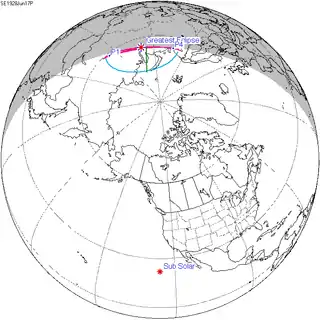 June 17, 1928 |
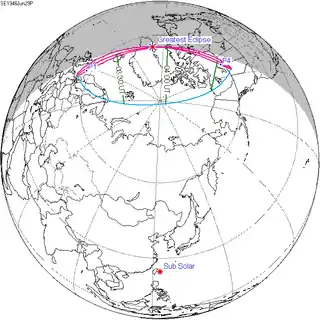 June 29, 1946 |
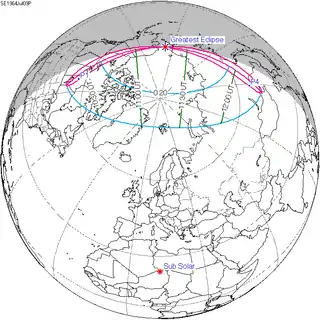 July 9, 1964 |
| 4 | 5 | 6 |
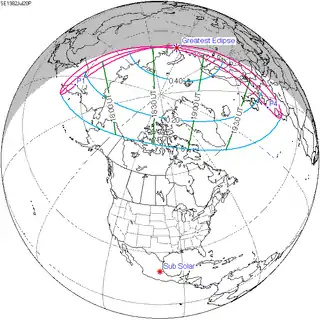 July 20, 1982 |
 July 31, 2000 |
 August 11, 2018 |
| 7 | 8 | 9 |
 August 21, 2036 |
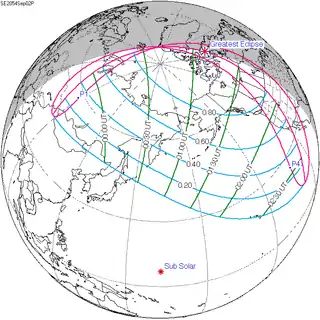 September 2, 2054 |
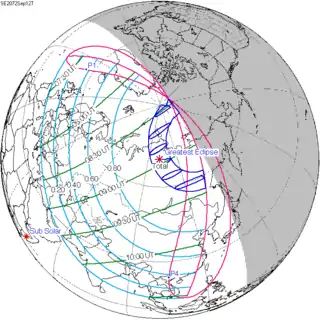 September 12, 2072 |
| 10 | ||
 September 23, 2090 | ||
Tritos
- Preceded: Annular on November 26, 2133
- Followed: Annular on September 26, 2155
Tzolkinex
- Preceded: Partial on September 15, 2137
- Followed: Annular on December 7–8, 2151
Octon
- Preceded: Annular on January 8, 2141
- Followed: Partial on August 14, 2148
Notes
- ↑ "Major Solar Eclipses Visible from New York, NY". eclipse.gsfc.nasa.gov.
- ↑ https://www.fourmilab.ch/earthview/pacalc.html
- ↑ "Total Solar Eclipse on October 26, 2144". www.timeanddate.com. Retrieved 2023-08-22.
- ↑ Saros Series Catalog of Solar Eclipses NASA Eclipse Web Site.